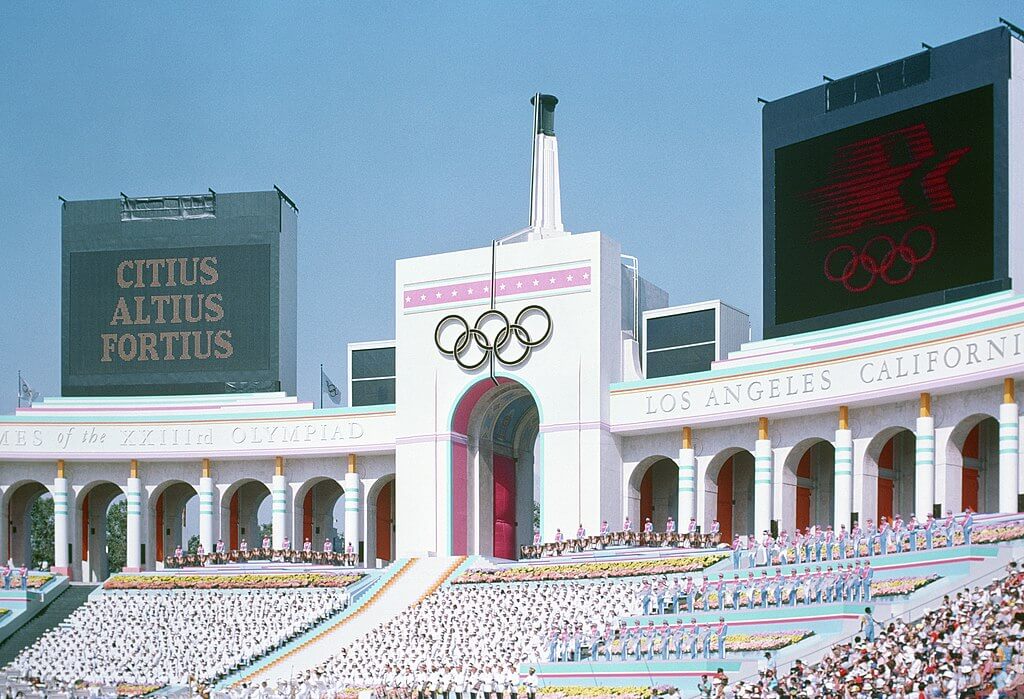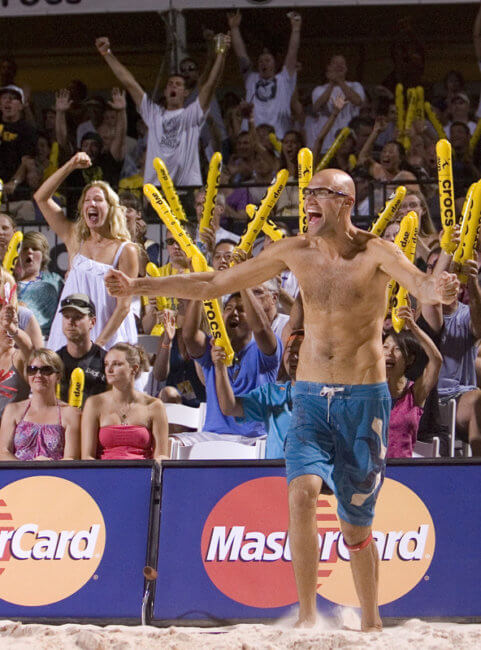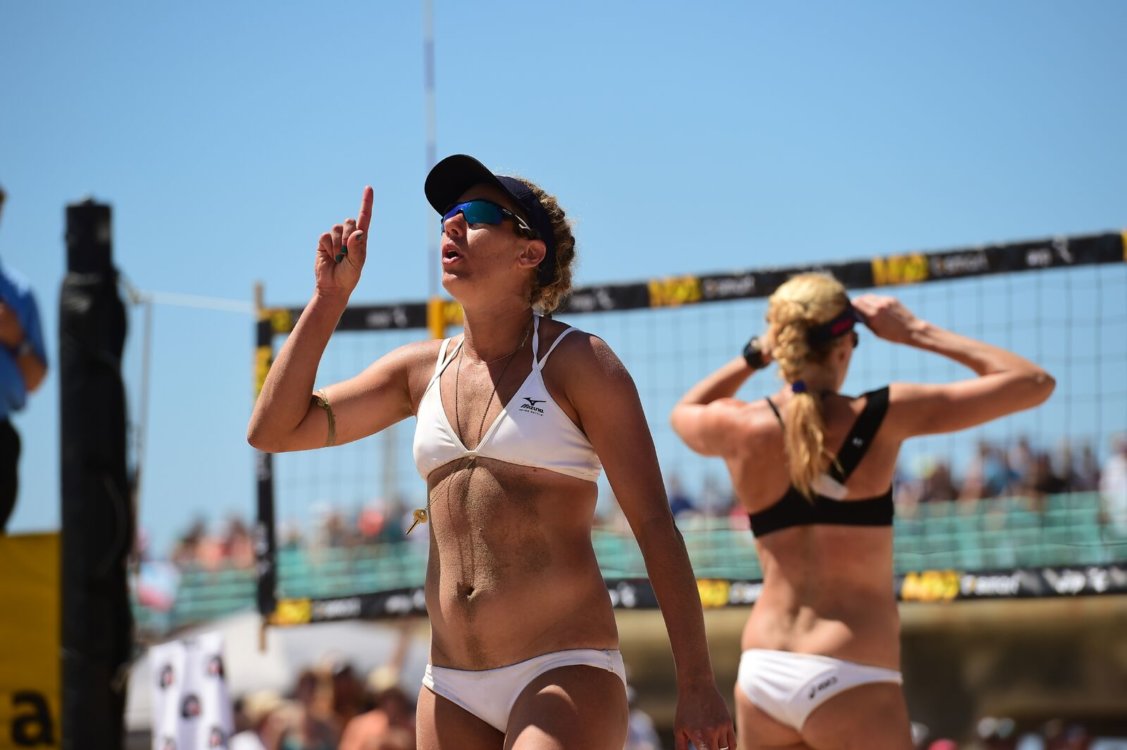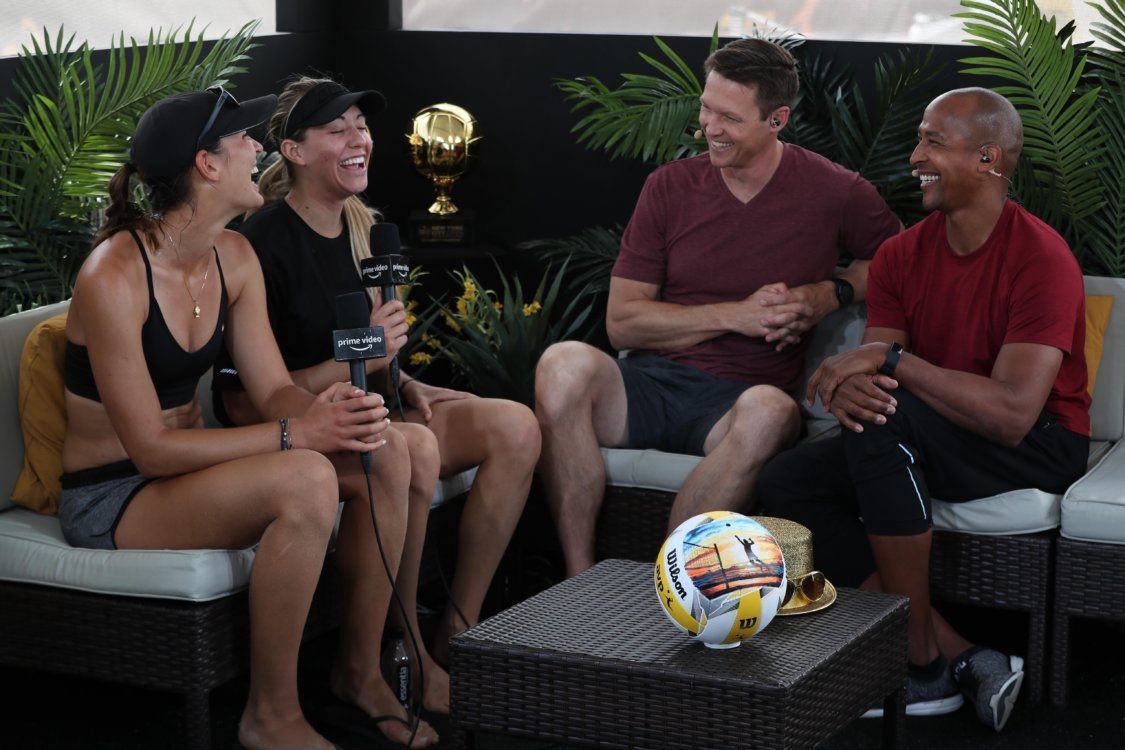When a sport gains Olympic status, like indoor volleyball did in 1957 and beach volleyball did in 1996, it feels like the gold stamp of approval from athletes and onlookers across the globe. That’s why there are always dozens of sports vying for inclusion, from baseball and MMA to wakeboarding and chess. However, volleyball hardly needed a stamp of approval to compete on the world stage; indoor volleyball had been a global sport for many years prior to its inclusion in the Olympics (we can give you a hand if you need a refresher on volleyball’s origin story). With that said, being part of the Games offers a unique level of visibility that has undoubtedly grown the international audience for both indoor and beach volleyball, not to mention the incredible sense of pride and accomplishment that Olympic athletes feel after earning the right to represent their home country.
Just how much history has been made since indoor volleyball and beach volleyball earned their coveted Olympic spots? Which legends are still in the industry giving younger players a leg up? Let’s take a look.
Let the (Olympic Volleyball) Games Begin
In 1957, 62 years after the sport was created, the International Olympic Committee deemed indoor volleyball an Olympic sport. However, indoor didn’t make its official debut in the Games until 1964, when the Olympics came to Tokyo for the first time (the 1940 Games were supposed to be the first, but then World War II happened).
The action in the Land of the Rising Sun was reportedly spectacular. On the men’s side, the competition came down to a battle between the USSR, Japan, and Czechoslovakia, with the USSR pulling out the gold. In the women’s event, Japan came out on top. With the home country celebrating their victory, the rest of the volleyball world had something else to celebrate; volleyball had become the first women’s team sport to be contested at the Olympic Games, a huge step forward for global gender equality.
Between 1964 and 1980, the USA Olympic volleyball team didn’t claim any spots on the podium, despite being the sport’s birth place. Instead, the USSR was a consistent top performer, taking gold in both the men and women’s events at the 1968 Mexico City Games (Japan’s men’s and women’s teams took silver; the bronze medal in men’s went to Czechoslovakia while the women’s bronze went to Poland). In Munich 1972 and Montreal 1976, Japan, the USSR, and Poland continued to dominate, with North Korea, Cuba, and South Korea also making impressive showings that earned them bronze medals. The results were similar at the Moscow 1980 Games, which were subject to a Western boycott due to the Soviet-Afghan War. 66 countries, including Japan and the U.S., joined the boycott. With a narrower field competing, Eastern Europe completed a full sweep; The gold, silver, and bronze on the men’s side went to the USSR, East Germany, and Bulgaria, respectively, and on the women’s side, the USSR took another gold with Bulgaria and Romania taking silver and bronze.
USA Volleyball Rising

The Olympics came to the United States, specifically the City of Angels, for the memorable 1984 Games. Global political entanglements continued, with fourteen Eastern Bloc countries boycotting in retaliation for the 1980 Western boycott, including the Soviet Union and East Germany. On the women’s side, China and the U.S. dueled, resulting in the former taking the gold, led by star player Lang Ping (the current coach of China’s women’s national indoor team). The bronze medal went to Japan. The U.S. men’s team overcame a pool play loss to Brazil to defeat them in the finals and capture the gold medal (Italy came in third). Among these U.S. Olympians were Karch Kiraly, the youngest on the team, and Paul Sunderland, one of the oldest players. These two medals made 1984 the first time (but not the last!) that the U.S.’s indoor national team medaled on the world’s most famous stage.
At the 1988 Seoul Olympics, the USSR was back in competition, but landed second to the U.S. men’s team, captained by Kiraly. Argentina upset a veteran Brazil team to capture bronze. On the women’s side, the USSR pulled back into first, followed by Peru and China. Then came the Barcelona Games in 1992, where Brazil’s men’s team earned their first Olympic gold medal. The Netherlands took silver while the U.S. came away with bronze. On the women’s side, Cuba reached gold, followed by the USSR with silver and the U.S. with bronze. Gone were the days when the USSR, Japan, and Czechoslovakia were the only game in town. From South America to the Far East, the competition was as fierce as it was diverse.

via godstoghosts.com
Olympic Beach Volleyball Begins
The year was 1996. The Olympic site? Back in the U.S., this time in Atlanta, Georgia. This was a landmark year for American volleyball, although you wouldn’t know it from looking at indoor volleyball’s podium (The Netherlands, Italy, and Yugoslavia’s men’s teams medalled alongside Cuba, China, and Brazil’s women’s teams). However, this was the unforgettable year that beach volleyball premiered at the Games. Karch Kiraly was back in the Olympics, this time accompanied by Kent Steffes, a young player out of UCLA who had notched AVP’s No. 1 ranking at the youngest age ever, 24. Together the pair claimed the first gold medal awarded for men’s beach volleyball. Silver went to two more American standouts, Mike Dodd and Mike Whitmarsh. If the men’s side had the U.S. written all over it, Brazil’s prowess was the takeaway for the women. Jackie Silva and Sandra Pires claimed gold with Mônica Rodrigues and Adriana Samuel taking home silver. Australia’s Natalie Cook and Kerri Pottharst closed out the podium with bronze. Yes, Oceania had entered the fray and they were serious contenders.
Olympian Volleyball Enters the 21st Century
The indoor winners of the Sydney Games, the first of the new millennium, looked similar to those in 1996. The Cuban women’s team claimed their third-straight gold medal, leaving Russia with the silver and Brazil with bronze. On the men’s side, Yugoslavia put on an incredible performance, with Vladimir and Nikola Grbić, Goran Vujevic, and Ivan Miljkovic leading the team to gold. Russia took another silver and Italy closed out with bronze.
In women’s beach, the high-performing Australian team that took bronze in 1996, Cook and Pottharst, dominated to close in on the gold in their home country. Brazil’s Shelda Bede and Adriana Behar, and Adriana Samuel and Sandra Pires took silver and bronze, respectively. Among the men’s national teams, a fast server named Dain Blanton teamed with Manhattan Beach local, Eric Fonoimoana to come out on top, leaving Brazil’s Zé Marco de Melo and Ricardo Santos to claim silver and Germany with bronze. Welcome to the 2000s.
Kerri and Misty Pull A Three-Peat

The Athens 2004 Games saw a victorious Chinese women’s indoor team beat Russia after trailing by two sets. Cuba, after three straight gold medals, settled for bronze. On the men’s side, Brazil claimed their second Olympic gold medal, followed by Italy with silver and Russia with bronze. Sorry, USA indoor… This one was a shutout.
In beach, Brazil’s Ricardo Santos beat his previous silver high from 2000 by taking gold in Athens, this time with Emanuel Rego. The nations that won silver and bronze were fresh-faced newcomers to the Olympic beach volleyball podium: Spain’s Javier Bosma and Pablo Herrera pulled into second and Switzerland’s Stefan Kobel and Patrick Heuscher rounded out the winners. On the women’s side, the U.S. teams made up for their lackluster showing in Sydney. Santa Clara-born blocker, Kerri Walsh (now Walsh Jennings), who played on the 2000 indoors team, competed with partner, Misty May-Treanor. The two, who had won all eight tournaments they entered in 2003, swept every set in their seven matches in Athens. Silver went to Brazil’s Shelda Bede and Adriana Behar, while U.S. beach volley veterans, Holly McPeak and Elaine Youngs bested Australians Natalie Cook and Nicole Sanderson to claim bronze.
Then came Beijing. The 2008 Games saw a renaissance for the U.S.’s indoor teams, with the men’s team dethroning Brazil to take home their first Olympic title in 20 years. That U.S. team included many names that will be familiar to fans of AVP and U.S. volleyball, including David Lee, Rich Lambourne, and Reid Priddy (if you’re curious about Priddy’s eventual journey from indoor to sand, we can help). Russia rounded out the podium with another bronze. The U.S. women’s team, coached by 1984 indoor gold medalist Lang Ping, also put on a top-tier performance, but fell to Brazil and took silver, followed by China with bronze.
The Bejing beach, meanwhile, produced fiery action that few will soon forget. Kerri Walsh and Misty May-Treanor defeated China’s Wang Jie and Tian Jia to take home their second gold medal, with bronze going to China in addition to the silver. On the men’s side, after enduring a first round loss to Latvia, Todd Rogers and then-up-and-comer Phil Dalhausser overcame Brazil’s Fábio Luiz Magalhães and Márcio Araújo to win it all in a stunning finals match (but don’t take our word for it— you can hear their perspective on that insane day). The bronze medal went home with 2004 Brazilian gold medalists, Ricardo Santos and Emanuel Rego.

Bringing us within a decade of the present day, the London 2012 Games saw the renaissance of the Russian and Japanese indoor teams that were so dominant in the first two decades of Olympic volleyball. Russia’s men’s team took home a gold medal (the nation’s first in indoor volleyball since 1980). Brazil nabbed silver and Italy overcame Bulgaria to secure a bronze. On the women’s side, Brazil managed to clinch gold with a victory over the U.S., while Japan defeated Korea to lock down the bronze.
Out on the beach, the women fared better. Kerri Walsh and Misty May-Treanor competed in what would be their last outing together, winning their third consecutive Olympic gold medal in an All-American final match against April Ross and Jennifer Kessy, who linked up in 2007. Brazil’s No. 1 seeded team, Juliana Felisberta and Larissa França took bronze. On the men’s side, Germany’s Julius Brink and Jonas Reckermann defeated Brazil’s Alison Cerutti and veteran, Emanuel Rego to take home Europe’s first gold medal in Olympic beach volleyball. Latvia’s Mārtiņš Pļaviņš (half of the team that defeated Rogers/Dalhausser in the preliminary round in 2008) and Jānis Šmēdiņš rounded out the podium.

The Last Olympics: Rio 2016
To bring us up to date, the most recent Summer Olympics took place in Rio de Janeiro in 2016. Brazil’s men’s team took the gold medal for indoor, defeating Italy to reclaim the top spot they had last reached in 2004. The U.S. took home bronze. On the women’s side, China nabbed their third Olympic gold medal in indoor with a victory over Serbia, who were competing for a medal for the first time. The U.S. women’s team won bronze after defeating the Netherlands.
In beach, Alison Cerutti improved on his 2012 silver medal by taking gold with partner Bruno Oscar Schmidt thanks to a victory over Italians Daniele Lupo and Paolo Nicolai. The bronze medal went to Alexander Brouwer and Robert Meeuwsen of the Netherlands. After taking home the gold in 2012 on the men’s side, Germany replicated the achievement with the women’s team in Rio; Laura Ludwig and Kira Walkenhorst defeated Brazil’s Ágatha Bednarczuk and Bárbara Seixas for this honor, with U.S. Olympians April Ross and Kerri Walsh Jennings taking bronze.
The Olympic Volleyball Legacy
One of the greatest things about previous Olympiads is how yesterday’s medalists often have a hand in developing the greats of today and tomorrow. China’s Lang Ping comes to mind as a 1984 indoor gold medalist who has gone on to coach the U.S. national team to a silver medal in Beijing and the Chinese team to a gold medal in Rio.
In the U.S, there are countless examples. Jen Kessy now coaches the dominant A-team, April Ross and Alix Klineman, who are favorites to compete in the Tokyo Games next year. 2008 indoor gold medalist, Rich Lambourne now coaches AVP all-stars and Olympic hopefuls Taylor Crabb and Jake Gibb, the latter of which represented the U.S. at the 2008 and 2012 Olympic Games with Sean Rosenthal. When you watch AVP tournaments on Amazon Prime Video, part of your commentary comes from gold medalist Dain Blanton and two-time indoor Olympian, Kevin Barnett. At the college level, Todd Rogers has been the head coach of the talented Cal Poly women’s beach volleyball team since 2016. There are also some generational ties, with Eric Fonoimoana’s niece, Falyn competing now in the AVP.

With Tokyo 2020 around the corner, the best of the best have already been facing off for months in hopes of securing a spot, and it’s anyone’s guess how it will all shake out. Canada’s only Olympic medal in beach was in 1996 (John Child and Mark Heese), but 2019 Beach Volleyball World Champions Sarah Pavan and Melissa Humana-Paredes are hoping to change that. From the looks of their performance on the global (and AVP) stage, they have a good shot. Europe is also a major medal contender, with Men’s team, Anders Mol and Christian Sorum putting Norway on the map for beach volleyball.
Whether you’re hoping to see the future Olympians of 2020, current athletes who can be traced back to 2000s-era-Olympians, or just some good old-fashioned heated beach volleyball, we hope to see you on our beach come May.